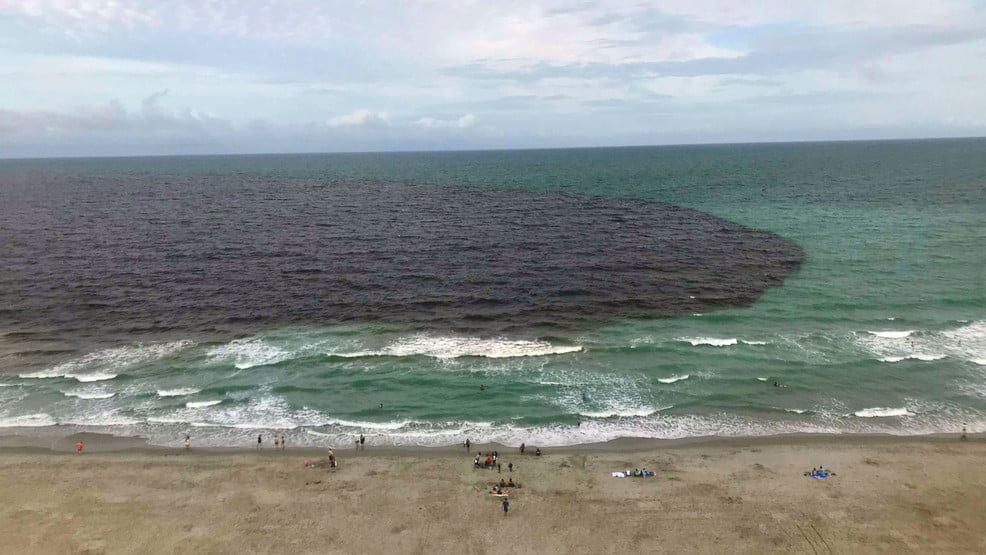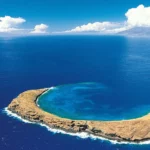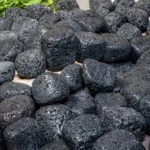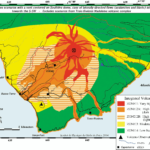You’ve probably never thought about dark spots in the ocean, but they’re fascinating! These patches of darkness puzzle scientists. Let’s journey into the deep to uncover the forces behind these shadowy spots, from plant life to volcanic activity. Join us as we explore the unseen world of the deep sea and unravel the secrets of these marine mysteries.
What are the Dark Spots in the Ocean?
Ever wondered what lurks in the depths of our planet’s vast oceans? We often picture the sun-kissed surface, teeming with life, but what about the places where sunlight fears to tread? Those, my friend, are the mysterious and fascinating “dark spots” of the ocean.
Sunlight, the engine of life as we know it, acts differently underwater. As it dives deeper and deeper, the water acts like a filter, slowly stripping away the colors of the rainbow. Reds and oranges disappear first, followed by yellows and greens. Eventually, only a faint, eerie blue remains, and even that gets swallowed by the darkness below.
This gradual descent into shadow creates different zones within the ocean:
| Zone | Depth (approx.) | Light Conditions | Life? |
|---|---|---|---|
| Sunlight Zone | 0-200 meters | Abundant | Thriving and diverse |
| Twilight Zone | 200-1000 meters | Dim, blue-green | Strange, adapted creatures |
| Midnight Zone | 1000-4000 meters | Pitch black | Bizarre, bioluminescent life |
| Abyssal Zone | 4000-6000 meters | Eternal darkness | Limited, resilient species |
| Hadal Zone | 6000+ meters | Unfathomable darkness | Largely unexplored |
The Hadal Zone, named after Hades, the Greek god of the underworld, is the deepest and darkest layer. Down here, the pressure is crushing, the temperature hovers just above freezing, and sunlight is but a distant memory. It’s a place of extremes, where only the most resilient creatures can survive.
But here’s the thing: it’s not just about the lack of light. The darkness itself has shaped the very life that exists there. Many animals in these deep, dark zones have evolved extraordinary adaptations, like bioluminescence – the ability to create their own light! Imagine shimmering jellyfish, anglerfish with glowing lures, and creatures flashing signals in the darkness. It’s like a hidden light show, hidden from our view.
Scientists are still trying to uncover all the secrets of these dark ocean depths. It’s challenging and expensive work, requiring specialized equipment and a whole lot of courage. Yet, the discoveries made in these extreme environments could revolutionize our understanding of life on Earth. Who knows what incredible adaptations, new species, or even potential resources might be waiting to be found?
Perhaps these dark spots hold the key to unlocking some of the biggest mysteries of our planet. Have you ever wondered what lies beneath the black water hole? The secrets hidden within these dark spots may be just as intriguing. It’s a humbling thought, isn’t it? That even in the 21st century, there are still unexplored frontiers right here on Earth, teeming with life that evolved in ways we can barely begin to imagine. The deep sea, with its shadowy corners and bioluminescent wonders, reminds us that there’s still so much to learn about the planet we call home. What other scary facts about the ocean are waiting to be discovered in these dark depths?
What are the dark areas in the sea?
We’ve already talked about how massive and mysterious the ocean is, but let’s dive deeper – literally! – into one of its most intriguing features: the dark areas.
While we often associate the ocean with shades of blue, the truth is that light behaves very differently in the underwater realm. As sunlight penetrates the water’s surface, it encounters water molecules and a plethora of suspended particles, from microscopic plankton to dissolved organic matter. These encounters cause the light to scatter and get absorbed.
The deeper you descend into the ocean, the more pronounced this effect becomes. Eventually, you reach a point where sunlight simply cannot penetrate – a realm of perpetual darkness known as the aphotic zone. This zone, beginning at depths of around 656 feet (200 meters), challenges our conventional understanding of life.
In the absence of sunlight, the primary source of energy in the aphotic zone becomes detritus, the decaying organic matter that slowly drifts down from the surface layers. Imagine a constant rain of dead plankton, algae, and other marine snow, providing sustenance to a surprisingly diverse array of creatures.
But the aphotic zone isn’t devoid of light altogether. In this world of eternal night, life has found a way to create its own illumination through bioluminescence. This fascinating phenomenon allows organisms to produce light through chemical reactions within their bodies. Imagine a jellyfish pulsing with an ethereal glow or a fish with a light dangling in front of its mouth, like a built-in fishing lure. These bioluminescent organisms turn the dark depths into a captivating light show, a testament to the adaptability and sheer weirdness of life on Earth.
Scientists are still unraveling the mysteries of the aphotic zone, and each new discovery just leads to more questions. What other bizarre creatures lurk in the darkness? How do they interact with their environment and each other in a world without sunlight? There’s a lot we don’t know, but one thing’s for sure: the dark areas of the sea are a treasure trove of scientific wonder and a reminder that our planet is full of surprises.
Why are some spots in the ocean darker than others?
The ocean’s surface often resembles a patchwork quilt of different colors, with some areas appearing significantly darker than others. These dark spots, like underwater shadows, are a testament to the interplay of various factors that influence the ocean’s appearance.
One of the primary reasons for these color variations is the depth of the water. Just like a flashlight beam gradually fades as it travels through a swimming pool, sunlight loses its intensity with increasing depth. As sunlight penetrates the water, it gets absorbed more and more. The deeper the water, the less light can bounce back up to the surface, making the water look darker.
Beyond depth, suspended particles play a critical role in shaping the ocean’s color palette. These particles, encompassing a wide range of materials like microscopic plants (phytoplankton), sediment, and even pollution, act like tiny mirrors scattering sunlight in different directions. High concentrations of these particles can limit light penetration, making the water appear darker and murkier.
Furthermore, the ocean floor itself contributes to the color scheme. Just as dark-colored clothing absorbs more heat from the sun, a dark ocean floor, covered in mud or volcanic rock, absorbs more light than a lighter-colored seabed composed of sand or coral reefs.
Interestingly, scientists are still unraveling the intricate web of factors that govern ocean color. The angle of the sun, the amount of wind, and even the presence of microscopic organisms can all influence how light interacts with water, leading to variations in color and clarity.
Ongoing research suggests that ocean color can provide valuable insights into the health and dynamics of marine ecosystems. By studying color patterns, scientists can track phytoplankton blooms, monitor pollution levels, and gain a better understanding of how climate change is impacting our oceans.
Why Are Some Parts of the Ocean Dark?
We’ve touched upon the mysterious darkness that engulfs certain parts of the ocean. Now, let’s delve deeper into the fascinating reasons behind this phenomenon.
Imagine sunlight as a flashlight beam piercing the ocean’s surface. As this light delves deeper, it encounters a multitude of water molecules and a myriad of tiny particles – a bustling metropolis of microscopic life and suspended matter. These encounters cause the light to bounce off in different directions, a process known as scattering.
Sunlight, however, isn’t a monolithic entity. It’s a vibrant spectrum of colors, each with its own wavelength. Water, it turns out, has a particular fondness for absorbing the longer wavelengths of light, especially those in the red and orange part of the spectrum. This selective absorption is why we perceive the ocean’s surface as a captivating blue.
As we venture deeper into the ocean’s embrace, those blue wavelengths, though more readily scattered, also begin to diminish. Below a certain depth, typically around 656 feet (200 meters), sunlight effectively surrenders to the darkness. This marks the beginning of the aphotic zone, a realm where sunlight’s life-giving energy can no longer penetrate.
The depth of the ocean floor also significantly influences the colors we perceive at the surface. A light-colored seabed, such as one composed of white sand or reflective rocks, acts like a mirror, bouncing sunlight back towards the surface and creating a brighter, more vibrant hue. Conversely, a dark ocean floor, often blanketed in mud or sediment, absorbs more light, contributing to a darker, more subdued appearance.
The ocean teems with life, and this life itself plays a crucial role in shaping the water’s color. Tiny, plant-like organisms called phytoplankton thrive in the sunlit upper layers of the ocean. These microscopic powerhouses, containing chlorophyll, the pigment responsible for photosynthesis, absorb sunlight as they convert it into energy. Large concentrations of phytoplankton can lend a greenish hue to the water, much like plants on land.
Other particles, such as sediment from rivers or decaying organic matter, can also influence the ocean’s appearance. High sediment loads, often occurring near river mouths or coastal areas, can make the water appear brown or murky, limiting light penetration.
Scientists are continuously working to unravel the intricate tapestry of factors that contribute to ocean darkness. It’s a complex interplay of physics, chemistry, and the ceaseless dance of life itself. However, one thing remains clear: the darkness of the ocean, far from being a void, is a testament to the dynamic forces that shape our planet and the remarkable adaptations of life that thrives in even the most extreme environments.
What is all the brown stuff floating in the ocean?
You’re strolling along the beach, enjoying the ocean breeze, when you notice patches of brown, frothy stuff floating on the water’s surface. It’s not exactly the most inviting sight, and you might find yourself wondering, “What is that stuff?”
That brownish goop is often a sign of a natural phenomenon known as a diatom bloom. Diatoms, a type of microscopic algae, are essential players in the ocean’s ecosystem, forming the base of many marine food webs. These tiny plants harness sunlight to produce energy through photosynthesis, just like their terrestrial counterparts.
Diatoms have a particular talent for multiplication. When conditions are favorable, such as ample sunlight and abundant nutrients, their population can explode, resulting in a diatom bloom. During these blooms, the water can take on a brownish or even reddish hue, depending on the species of diatoms involved.
But what about that slimy texture? Diatoms produce a sticky mucus that helps them adhere to surfaces, including each other. When their numbers skyrocket during a bloom, this mucus can clump together, forming large, floating mats that resemble brown froth.
While diatom blooms are a natural part of a healthy ocean ecosystem, excessive blooms, often fueled by nutrient pollution from human activities, can sometimes have negative consequences. For instance, large blooms can block sunlight from reaching underwater plants, disrupting the delicate balance of marine life. Additionally, when the diatoms in a bloom eventually die, their decomposition consumes oxygen in the water, potentially harming fish and other marine creatures.
Scientists closely monitor diatom blooms and other phytoplankton populations to better understand their role in the marine ecosystem and how they might be influenced by factors like climate change and pollution. Their research helps ensure the long-term health of our oceans and the incredible biodiversity they support.
So, the next time you encounter a patch of brown “stuff” in the ocean, remember the fascinating world of diatoms. While it might not be the most picturesque sight, it’s a reminder of the intricate processes that sustain life in our planet’s vast and awe-inspiring oceans.
- Unveiling Bernhard Caesar Einstein’s Scientific Achievements: A Legacy in Engineering - July 15, 2025
- Uncover who is Jerry McSorley: CEO, Family Man, Business Success Story - July 15, 2025
- Discover Bernhard Caesar Einstein’s Scientific Contributions: Unveiling a Legacy Beyond Einstein - July 15, 2025















